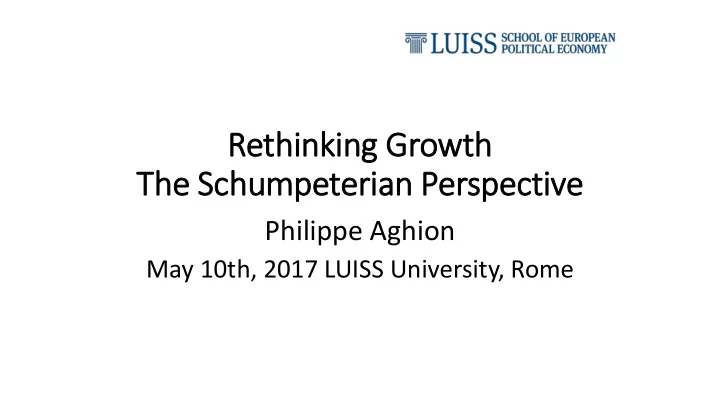

Rethinking Growth The Schumpeterian Perspective Philippe Aghion May 10th, 2017 LUISS University, Rome
Peter Howitt
Joseph Schumpeter
Sc Schumpeterian growth th theory ry • Long-run growth driven by innovations • Innovations result from entrepreneurial activities motivated by prospect of innovation rents • Creative destruction: new innovations displace old technologies
Ufuk Akcigit
Competition and growth: theoretical prediction
Competition and growth: empirical relationship
Richard Blundell
Competition, growth and distance to frontier
Competition and growth: the inverted-U relationship
Outline • Introduction • Growth enigmas • “Next”
Growth enigmas • The middle income trap • The debate on secular stagnation • Innovation, inequality, and social mobility
Argentinian versus US per capita GDP
Frontier innovation vs catch up growth
Enhancing productivity growth in advanced countries - Liberalization of product market - Investment in higher education - Liberalization of labor market
Enhancing productivity growth in emerging market economies • Foster technology transfers • Reallocate factors • Improve management practices
Long run growth effect of1000$ per-person spending on education
Fabrizio Zil ilibotti EEA Presidential Address
Growth enigmas • The middle income trap • The debate on secular stagnation • Innovation, inequality, and social mobility
Secular stagnation? • Gordon and the fruit-bearing tree approach • Summers and the keynesian approach
Two productivity growth waves United States: HP filtering of Productivity growth with λ =500 5% 4% Trend of productivity growth rate 3% 2% 1% 0% 1891 1901 1911 1921 1931 1941 1951 1961 1971 1981 1991 2001 2011 Total factor Productivity Labor Productivity
Secular stagnation? • Dale Jorgenson • Missing Growth • Europe
Sweden versus Japan
Country-specific productivity breaks Reformers Netherlands: Wassenaard agreement, 1982 • TFP growth : 1977-1983 0,5 %, 1983-2002 1,5 % Canada , reforms initiated in early 1990s • TFP growth: 1974-1990 0,3 %, 1990-2000 1,1 % Australia , reforms initiated in early 1990s • TFP growth: 1971-1990 0,4 %, 1990-2002 1,4 % Sweden , reforms initiated in early 1990s • TFP growth: 1976-1992 0,4 %, 1992-2008 1,9 %
Growth enigmas • The middle income trap • The debate on secular stagnation • Innovation, inequality and social mobility
Income shares at the very top over last 100 years: US top 1% increases from 9% in 1978 to 22% in 2012 30 25 US Top 1% 20 Percentile Share 15 US Top 0.1% 10 5 0 1918 1920 1922 1924 1926 1928 1930 1932 1934 1936 1938 1940 1942 1944 1946 1948 1950 1952 1954 1956 1958 1960 1962 1964 1966 1968 1970 1972 1974 1976 1978 1980 1982 1984 1986 1988 1990 1992 1994 1996 1998 2000 2002 2004 2006 2008 2010 2012 U.S. Top 1% U.S. Top 0.1% Source : Atkinson, Piketty & Saez; High Income Database
Two main ideas • Different measures of inequality which must be looked at differently • Top income inequality, “ Gini ”, social mobility • Innovation is a source of top income inequality which differs from other sources (entry barriers,..) • *Steve Jobs* versus *Carlos Slim*
Why innovation differs from other sources of top 1% increase? • Generates growth (we know) • But in addition, *we* show that: • Innovation generates temporary rents (imitation and creative destruction) • Innovation enhances social mobility (creative destruction) • Innovation does not increase broad inequality
Innovation and Top Income Inequality Philippe Aghion (LSE) Ufuk Akcigit (Chicago) Antonin Bergeaud (LSE) Richard Blundell (UCL) David Hemous (Zurich)
By contrast, lobbying… • Increases top income inequality • Increases inequality at large • Reduces social mobility • Does not enhance growth
Lobbying VS Top1% (USA)
Lobbying VS GINI (USA)
Looking ahead
Growth meets development • Hsieh and Klenow • Akcigit, Alp and Peters
Link between the age and the size of firms
Distribution of firms productivity
Becoming an in inventor
Becoming an in inventor • Akcigit, Toivanen, Vaananen (Finland) • Bell, Chetty, Jaravel, Van Reenen (US)
In Introduction • Basic questions : 1. What determines who become inventors? 2. Income mobility of inventors versus non-inventors?
Probability of Becoming and In Inventor: IQ IQ
Probability of Becoming and In Inventor
Probability of Becoming and In Inventor
Probability of Becoming and In Inventor
Probability of Becoming and In Inventor
Conclusion • We have proposed a new theory but also a new way to do growth theory, through continuous dialogue with micro-data • Our purpose was both, to better understand the growth process and also to rethink growth policy • Addressing growth enigmas is useful, not only to satisfy our scientific curiosity, but also for society
Recommend
More recommend